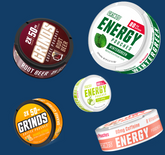How to Quit Chewing Tobacco: Cut the Habit Quickly & Painlessly With These Tips
 Want to learn how to quit chewing tobacco? You’ve come to the right place. Today, we’re going to empower you with the advice that countless others have used to cut the habit quickly and painlessly. By the time you finish reading this article, you’ll feel confident in your next steps along your journey to making your chewing tobacco habit a thing of the past.
Want to learn how to quit chewing tobacco? You’ve come to the right place. Today, we’re going to empower you with the advice that countless others have used to cut the habit quickly and painlessly. By the time you finish reading this article, you’ll feel confident in your next steps along your journey to making your chewing tobacco habit a thing of the past.
Chewing tobacco doesn’t just degrade your oral health and cost you a fortune over the course of your lifetime - it can affect your social life, too. But the real danger comes in the fact that this habit is slowly (but surely) killing you - whether it be mouth cancer, lung problems, or stomach complications. And we’ve not even mentioned the toll this addiction is taking on your mental health either.
In order to help you set out on the right foot along your journey to quitting chewing tobacco, we want to start with a grave warning on what fate awaits you if you prolong this decision or fail to take action whatsoever.
Learning How to Quit Chewing Tobacco Today Could Save Your Life…
Maybe you’ve tried to quit chewing tobacco before but found yourself giving in to cravings quickly. Perhaps this is your first time taking the leap to become chewing tobacco-free. Either way, we want to kick this conversation into gear by discussing the importance of learning how to quit chewing tobacco - and actually committing to the path ahead.
If you haven’t done so already, we encourage you to read our article on how bad chewing tobacco is really. Many individuals who are addicted to chewing tobacco are simply unaware of just how serious the consequences are. And the sooner you realize what this habit is doing to your physical and mental health, the sooner you’ll want to begin the journey.
First, let’s talk about the part of your body that feels the effects of chewing tobacco the most - your mouth. The most minor of consequences are stained teeth and bad breath - but that’s just the beginning. These unpleasant symptoms quickly turn into serious health risks as your likelihood of gum disease, tooth decay, and most importantly, oral cancer all rise.
When considering what in chewing tobacco causes cancer, it’s no shock that so many cases of oral cancer can be traced back to a chewing tobacco habit. There are as many as 28 different carcinogens in chewing tobacco.
And, the health complications aren’t limited to just your mouth. There is a direct correlation between the constant use of chewing tobacco and stomach problems. This is true even if you don’t swallow your dip. And, chewing tobacco can affect your lungs too.
Beyond the fact that this addiction will lead to your demise if you don’t address it, it can affect your appearance too - and thus your confidence. We recently wrote articles addressing how chewing tobacco causes hair loss and nicotine causes acne. Not only will chewing tobacco affect your self-worth, but it can also cause other mental health issues like anxiety, irritability, brain fog, and more.
All things considered, learning how to quit a chewing tobacco habit is one of the best decisions you can make. You’re choosing to prioritize your health and well-being - even though you know it’s going to be an uncomfortable process. So - with that said, allow us to point you in the right direction below as we teach you how to quit chewing tobacco.
How to Quit Chewing Tobacco Habits As Quickly & Painlessly as Possible
In this section, we’re going to unpack everything you need to know as you set out on the journey to make your addiction to chewing tobacco a problem of the past. We’ll help you weigh all your options - like quitting cold turkey vs weaning yourself off, using nicotine replacement therapy vs more natural methods, and a whole lot more. But to help you commit to this major lifestyle change, we need to start with a why.
Start With a “Why”
Maybe that conversation on what chewing tobacco is doing to your mind and body is enough to convince you that this change needs to happen. Maybe you’ve seen what this addiction is costing you financially over the course of a year. Perhaps someone really important in your life has expressed their distaste for this nasty habit and you don’t want to upset them any longer.
Either way, you need to sit down and come up with a “why” for quitting. In this, you should be as specific as possible and get to the root of why you want to quit. Simply choosing to quit because you want to be healthier isn’t strong enough. If you have a journal, jot down all the ways your life will improve as a result of quitting chew:
- You’ll become physically healthier and lower your risk of early death or painful health complications. If you have to take a deeper dive into the rabbit hole of what chewing tobacco does to you, so be it. Look up pictures of the oral health of habitual chewers and read their stories. It’s too late for them - but it doesn’t have to be for you.
- You’ll save a ton of money over the course of your life. Run the numbers on how much you pay for chewing tobacco a month and then think about what you could do with those funds over the course of a few years. It’ll probably shock you.
- Your social life will improve. You aren’t thinking about your next dip as you hang out with friends - you can be more present. You won’t find yourself lashing out without reason because your cravings are causing you to be irritable or anxious. You won’t be afraid to talk to another person face to face because of chewing-tobacco-breath. You could save that relationship that’s on the ropes as a result of your habit.
These are just a few of the “why’s” you can come up with - but the main takeaway here is that you must be as detailed and thorough as possible in your reasoning for quitting. This will ensure you are fully committing to the lifestyle change.
Set a Date to Quit & Ask Loved Ones to Hold you Accountable
Once you have a better grasp on why you’re going through all the work of learning how to quit a chewing tobacco habit, it’s time to put pen to paper and set a date to quit. We know what you’re thinking…why can’t I just quit today?
You can - and we fully endorse that decision. But, giving yourself a few days to prepare will ensure a more smooth transition that sticks. This gives you time to come up with a plan for how you’ll handle withdrawal symptoms and triggers (which we’ll discuss next). It also gives you time to talk with loved ones in your life that you trust to hold you accountable.
For many individuals, the thought of letting down the people who matter most is more motivating than the thought of quitting on yourself. That’s why we recommend talking to parents, siblings, significant others, mentors, best friends - whoever it is that you don’t want to let down, and who you feel comfortable talking about this life change with.
Tell them of your ambitions to quit, and ask them to check in with you and hold you accountable throughout this journey. You’ll need to lean on them as you face withdrawal symptoms and triggers…
Prepare to Face Withdrawal Symptoms & Triggers
If quitting dip was as easy as throwing out your tins and never looking back, we wouldn’t be here teaching you how to quit chewing tobacco. The reality is, this is a really tough process. The reason for that is withdrawal symptoms and triggers.
The chewing tobacco withdrawal symptoms can be brutal - especially early on. They’ll have you questioning your “why” for quitting (which is why it needs to be bulletproof) and wondering if it’s even worth it (it is). But the good news is that they don’t last forever. Here are a few symptoms you should prepare to face:
- Headaches
- Cravings
- Irritability
- Anxiety
- Weight gain
- Insomnia
- Difficulty concentrating
As painful as these are, we will empower you with tools to navigate them in just a few moments. We also want to talk about triggers. These are things that make you think about chewing tobacco - and can lead to cravings. Maybe your triggers are specific events that you used to chew for (like baseball games, road trips, work, you name it). Triggers can also be as simple as a song or person that reminds you of chewing.
The point is, you’ll need to be prepared for withdrawal symptoms and triggers to test your commitment to ridding yourself of this nasty habit. Below, we’ll provide you a few ways you can do just that.
Have Coping Mechanisms in Place For These Symptoms/Triggers
If you only take one thing away from this guide on how to quit chewing tobacco, let it be this: you need coping mechanisms/tools in place for handling the symptoms and triggers we described above! This will prevent you from falling victim to them and running to the store for a tin of chew.
There are quite a few options here. Many of them are just good advice in general:
- Exercise can help to reduce stress and improve mood, which can be beneficial during the quitting process.
- Eating nutritious foods can help provide support for your body as it goes through this transition.
- Drinking plenty of water throughout the day. Staying hydrated is important for overall health and well-being, especially during this period.
- Finding activities that bring joy such as reading or listening to music. This can help take your mind off of the withdrawals and cravings you might be experiencing.
- Talking with friends or family members who understand what you are going through, as they can provide emotional support and advice on how best to cope with withdrawal symptoms and triggers.
- Practice mindfulness & meditation to become mentally stronger. This will help you fight against the urge to give in to cravings or triggers.
But many times, these tactics will fall short - and you’ll still find yourself suffering from withdrawal symptoms or craving chewing tobacco. You need something stronger that can address withdrawal symptoms head-on and kick cravings to the curb. And that’s where our nicotine & tobacco-free chew comes in.
Grinds caffeine pouches are considered the #1 dip replacement. These pouches simulate the experience of dipping, which is oftentimes enough to quell those cravings you’ll experience. The mere act of throwing a pouch in may end up being your best defense against these feelings.
But, the addition of caffeine takes things a step further, simulating that buzz you get from chewing tobacco with a nice kick of energy. This also helps you overcome some of the most challenging withdrawal symptoms like headaches, fatigue, irritability, and more.
You can choose from an array of flavors - but for those who are quitting chewing tobacco, we recommend wintergreen. This will further enhance the effectiveness of your coping mechanism as it tastes exactly how you remember chewing tobacco.
Should You Use Nicotine Gum, Patches, or Other Replacement Therapies?
Beyond having Grinds in your arsenal, you may be wondering about other products that can help you overcome cravings/withdrawals - like nicotine gum, patches, or other forms of nicotine replacement therapy.
While these do work for many, we actually advise against them. And there’s a reason why. They simply replace one nicotine addiction with another. Today, you’re wondering how to quit chewing tobacco. But after NRT, you may come back here wondering how to get off nicotine gum.
We view these therapies as kicking the can further down the road. Eventually, you’ll need to bite the bullet and quit all forms of nicotine - so why not take this approach from the start and avoid having to go through withdrawal symptoms more than once?
Slowly Tapering Yourself Off Chewing Tobacco vs Quitting Chewing Tobacco Cold Turkey
There are two approaches to quitting chewing tobacco. You can slowly taper yourself off, lowering your intake on a daily basis until eventually, you are 100% chew-free. Or, you can consider the other technique: quitting dipping cold turkey.
Obviously, one of these is more painful and challenging than the other - and that’s quitting cold turkey. You’ll be hit with much harder withdrawal symptoms and cravings as you shock your body by removing a substance it has become so dependent on. Thus, the likelihood of relapsing and ending up back on the dip is higher for those who take this approach.
If you decide to slowly wean yourself off chewing tobacco, you can consider a gradual reduction of 10%-25% of your habit daily. For example - if you chew 4 times a day, you should only chew 3 times tomorrow. Then, only twice the next day. Before you know it, you’re not chewing at all - and you can start to reward yourself for key milestones along the way.
Reward Yourself For Key Milestones As You Quit Chewing Tobacco
Throughout this journey, key milestones must be celebrated - this will incentivize you to keep on the right path. You’ve worked hard and deserve to treat yourself for these accomplishments.
Celebrate your first day without a single chew by taking yourself and a loved one who’s helped you get there out to dinner. After a month, maybe consider rewarding yourself with something a bit bigger - like a nice bottle of liquor, a shopping spree at your favorite store, getting your car detailed - whatever motivates you to get there. After 6 months or a year without chewing tobacco, take yourself on a nice vacation.
The possibilities are endless in terms of what milestones you set and the associated rewards. But because humans respond so well to reward systems like this, it’s imperative that you configure something of this sort into your journey.
How Long Does it Take to Quit Chewing Tobacco?
You came here to learn how to quit chewing tobacco as fast and painlessly as possible. How long is this going to take, though? How far out is the light at the end of the tunnel?
This is such a personalized journey that we can’t really provide you with a one-size-fits-all answer. It’s dependent on how long you’ve been chewing and how much you chew - along with your individual willpower and how closely you follow our advice above.
With that said, you can expect this process to take anywhere from a few weeks to several months. We’re including the withdrawal process in that estimation - which means you can live a normal, uninhibited life again that quickly. So, why not start your journey to quit dipping today?
Final Thoughts on How to Quit Chewing Tobacco
There you have it - how to quit a chewing tobacco habit step by step. We began this conversation with a discussion on what your habit is doing to your physical and mental health - and we want to bring it back there to remind you of why you need to take immediate steps to kick this habit to the curb.
Now that you know how to stop dipping, there’s really just one thing left to do. Head over to Grinds and get the chewing tobacco alternatives you need to fight this addiction with ease. Armed with the advice above and our tobacco & nicotine free pouches, you can quit chewing tobacco today!




